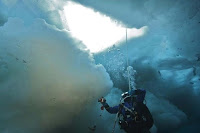 And you thought your place of work got chilly in the winter.
And you thought your place of work got chilly in the winter.
If you want to know how polar bears are doing, it's not enough to spy on them with satellite telemetry and other technology. You have to go where they live.
You have to tap into the stories these bears carry in and on their bodies, and drop in on the tiniest of organisms beneath the places they walk, the ones that feed the shrimp-like creatures that feed the fish that feed the seals that feed the bears.
That's what scientists did for five weeks this fall aboard the U.S. Coast Guard Cutter Polar Sea as they addressed the question: How are polar bears coping with sea-ice loss due to climate change?
To get some answers, they traveled to a part of the world few get to see, and far fewer get to see from beneath the sea ice. Or would want to.
"It's definitely not for everyone," said Katrin Iken, associate professor of marine biology at the University of Alaska Fairbanks, who led the team of ice researchers from UAF.
The ice divers, layered in polypropylene, fleece and dry suits, went to work through holes cut in the ice to gather samples from biological communities associated with sea ice. Tethered to a team member above, they went as deep as 40 feet to explore the bottoms of ice ridges -- the underwater version of the pressure ridges up top -- for a look at what lives down there.
In the big picture, it's all about understanding what melting ice means to the larger food web in the Arctic.
To Iken, the underside of sea ice is a beautiful and fascinating place.
Continue reading...
Don't forget to check out the photos.

Well done with the post.
ReplyDeleteGood job!